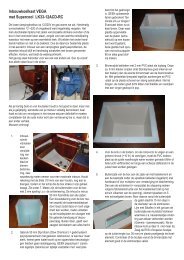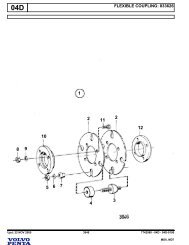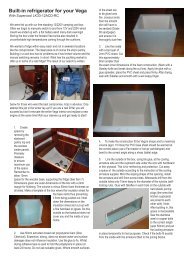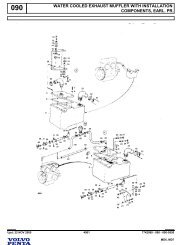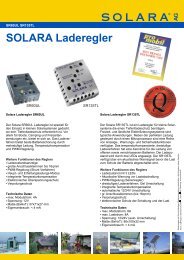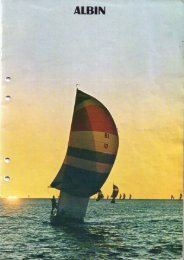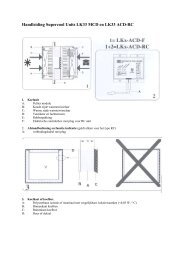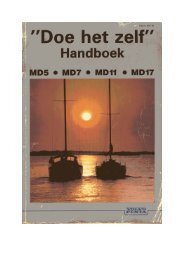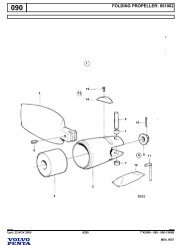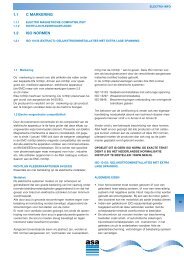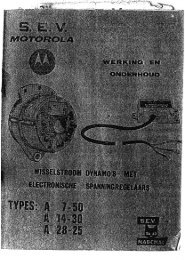How to build your own Vega-rudder
How to build your own Vega-rudder
How to build your own Vega-rudder
Create successful ePaper yourself
Turn your PDF publications into a flip-book with our unique Google optimized e-Paper software.
Holland, February 2005.This document was originally written by Lodewijk Cornelissen <strong>to</strong>gether with Arend Schramin the Dutch language. It is a full report including pictures and a drawing about <strong>build</strong>ing awood-epoxy <strong>rudder</strong> for a <strong>Vega</strong>. Because there are not <strong>to</strong>o many members on this forum whocan read Dutch, Rob Kloosterman, Steve Birch and I made an English translation. I wouldlike <strong>to</strong> thank everybody for their help and for sharing their knowledge.Regards, Jan van Craaikamp.<strong>How</strong> <strong>to</strong> <strong>build</strong> <strong>your</strong> <strong>own</strong> <strong>Vega</strong>-<strong>rudder</strong>When do you need <strong>to</strong> replace <strong>your</strong> <strong>rudder</strong>?That is difficult question. In my particular case it was clear, I had cracks and openings alongand under the stainless steel <strong>rudder</strong> shaft. This happened because the polyester came apartfrom the stainless steel shaft. The original polyester <strong>rudder</strong> consists of two parts in which the<strong>rudder</strong> shaft with side supports (tangs) is laminated. The edges on the inner side are shaped by3 - 4 cm of polyester paste <strong>to</strong> glue <strong>to</strong>gether the two parts. Moreover, in the inside a lot ofpolyester is used <strong>to</strong> glue <strong>to</strong>gether the stainless steel supports and the thin part (appr. 2 cmthick) of the <strong>rudder</strong> blade which is almost solid polyester. The hollow spaces above, betweenand under the supports are filled with PU foam. If cracks appear, water can penetrate whichwill be absorbed by the foam. If this water freezes it will expand and split the <strong>rudder</strong> blade.Unfortunately you cannot see through the <strong>rudder</strong> blade. The force I needed <strong>to</strong> split the old<strong>rudder</strong> showed me that <strong>Vega</strong> <strong>rudder</strong>s are stronger than expected and will not just fall apart.HOWEVER... from the outside you can never see the real condition of the blade. Once youhave cracks in <strong>your</strong> <strong>rudder</strong> it is just a matter time, depending on the climate, before <strong>your</strong><strong>rudder</strong> will need <strong>to</strong> be checked. My ship was imported from Sweden and had apparently metthe real winter weather there. Maybe I could have done some extra years with my old <strong>rudder</strong>but I did not want <strong>to</strong> take the risk as I sail on both coastal and tidal waters.Lets get going.For the new <strong>rudder</strong> I chose <strong>to</strong> use wood and epoxy for the manufacture. This is because I ammore familiar with wood and epoxy than with polyester. I could have drawn a mould of theold <strong>rudder</strong> and built it the same way as the original one but you need a lot of extras like apressure box <strong>to</strong> keep everything in shape. When you inject the foam, it will start expandingand create enormous forces on the blade halves. If you <strong>build</strong> a solid epoxy <strong>rudder</strong> it will be<strong>to</strong>o heavy and will wear out the <strong>rudder</strong> shoe bearing. A wood-epoxy <strong>rudder</strong> also has its’disadvantages. In fact the core will be of plywood has <strong>to</strong> be made impermeable with an epoxycoating.
Consider epoxy as a kind of paint used <strong>to</strong> protect wood against the ingress of water. Theepoxy layer is thinner than the original polyester gelcoat. Being an extension of the keel, the<strong>rudder</strong> base is more vulnerable than a shorter free <strong>rudder</strong>. That is the reason why I have paidextra attention <strong>to</strong> the laminate protection applied <strong>to</strong> the new <strong>rudder</strong>, as you will see later inthis article.The correct measurement (measure twice, cut once !)Check in advance the measurements of <strong>your</strong> existing <strong>rudder</strong> with my drawing and note thepossible differences. See appendix :Roerblad tek.pdfTo split the old <strong>rudder</strong> bladeTIP: Immediately purchase a professional mouth cover and goggles. Do not use the simplethrowaway things. The dust is very thin and will get through the cheaper filters. Cover theworkshop from ceiling <strong>to</strong> floor with sheets or work outside (check the air humidity andtemperature are within limits).Make a deep cut with an angle grinder around the outside of the polyester blade as deeply aspossible in<strong>to</strong> the thin leading edge around the <strong>rudder</strong> shaft. Avoid damage <strong>to</strong> the <strong>rudder</strong> shaftas much as possible. Make some small wooden wedges and hammer them in<strong>to</strong> the cut thatyou made in the polyester. The edges will break open. After that you can use a chisel, crowbaror heavy screwdrivers <strong>to</strong> get deeper in the material <strong>to</strong> break it open. This is a job for two pairsof hands. With some force the parts will break open without damaging the <strong>rudder</strong> shaft orsupports (tangs). Remove the <strong>rudder</strong> shaft and use, if possible, an undamaged half side of the<strong>rudder</strong> blade for measurement checks.TIP: Check the <strong>rudder</strong> shaft, particularly where welded, and ensure it is straight and strong.TIP: If you are going <strong>to</strong> glue the two wooden halves <strong>to</strong>gether you should make sure that youglue the upper sides from the same sheet <strong>to</strong>gether. This ensures the structure and grain of thewood is identical and the thickness of the layers on the outside will be the same since theycome from the same sheet. You will now end up with a rectangular blade, identical on bothsides, before the shaping and laminating begins.WoodYou will need two 50 cm x 120 cm x 30 mm sheets made from marine grade plywood. Firs<strong>to</strong>f all cut out the shape of the <strong>rudder</strong> shaft. With a circular saw - saw blade width of 3 mm –make a ' half circle ' cut according <strong>to</strong> the drawing and description <strong>to</strong> take the <strong>rudder</strong> shaft andtangs. See APPENDIX: Roerkoninguitsp.pdfTIP: Make the outer parts approx. 1 cm extra wood (flesh) along the <strong>rudder</strong> shaft. You canremove the extra wood after gluing the parts <strong>to</strong>gether as it is possible that you won’t glue thetwo parts <strong>to</strong>gether in the exact position.Adjust the saw according <strong>to</strong> indications with the support slide on e.g.. 25 mm (not on 17mm!). Use the 15 cm space of upper side of the <strong>rudder</strong> blade <strong>to</strong> check the saw adjustment.This part will be cut off at a later stage. Once you have made the cut in the first piececorrectly carry on and do the cut, in mirror image, in the opposite piece of plywood. Keep thedepth fixed and adjust the slide on the interior cuts. First you finish the cuts until the width isenough then you start <strong>to</strong> make deeper cuts <strong>to</strong> the middle until you have the proper shape of the<strong>rudder</strong> shaft according <strong>to</strong> the drawing.
Shaping the <strong>rudder</strong>bladeThe <strong>rudder</strong> blade tapers, according <strong>to</strong> my measurements, in one direction from 60mm <strong>to</strong> 8mm. After deducting the thickness of the epoxy it will be from approximately 58mm <strong>to</strong> 6 mm.We have <strong>to</strong> plane now, from the thin <strong>to</strong> the wide side. Use an electric plane till approx 90% ofdesired thickness has been obtained. To get a smooth surface, plane crosswise. The planedlayers show exactly how far you are by equal width and whether or not running parallel. Theyau<strong>to</strong>matically show “heightlines”. Now use <strong>your</strong> sharp manual Stanley plane. With that youcan feel what you do compared <strong>to</strong> an electric plane. The “heightlines” run now maximumparallel and maximum equal width. Finish with a sander. Sanding sides and rounding bows.You now hold, with pride, <strong>your</strong> new <strong>Vega</strong> <strong>rudder</strong> after nearly 8 hours of labour and <strong>to</strong>il. Notethat the rock hard epoxy layers of the wood will blunt <strong>your</strong> plane in no time at all.Layering the epoxySanded, dust and greasefree, coat the outside until impregnated. Sand, dust and greasefreeagain and so on. Hang it between two trestles, one side in the epoxy, cover with glassclothand roll until all the air has disappeared, the cloth must be saturated completely so there arenow white spots showing.Note well: Afterwards past with epoxy <strong>to</strong> <strong>build</strong> up the thickness again. Fold back the otherside of the cloth, apply epoxy and roll the cloth from the <strong>to</strong>p. Roll well at the edges. Crosscutends tapering from 60mm <strong>to</strong> 8mm are being held square and sharp <strong>to</strong> stimulate the looseningwater. This is in contrary <strong>to</strong> the original old blade which ends sharp (progress in techniques).The <strong>rudder</strong>blade is loosening water; the swirlings meet each other well behind the<strong>rudder</strong>blade.Cut excess cloth at one side less than blade thickness. And fold around the edge. The otherside is then folded over completely. Next layers of glasscloth are applied with reverse folding.By doing this bit extra reinforcement is built at the crosscut ends. The bot<strong>to</strong>m of the <strong>rudder</strong>,an extention of the keel, is less vulnerable if the <strong>Vega</strong> grounds.PLEASE NOTE: The so called “envelope covering” with glasscloth in v-form by foldingboth edges over each other) is only possible from the <strong>rudder</strong>shaft side because of the “5 edgesform” of the <strong>Vega</strong> <strong>rudder</strong>. If done the other way around it will become a mess since the clothwill collapse. Moreover, the 8 mm edge is so thin that the cloth will become loose and willstand proud. I have applied an extra 20cm wide strip around the backside edge (thus the edgeis 10cm wide) and brought in<strong>to</strong> the edge by cutting in. With a little bit of craftsmanship andcare you can shape the cloth around the <strong>rudder</strong>shaft connection.TIP: Rounding of the cloth or sharp thin edges can be overcome during the drying process.After some 2 or 3 hours the pressed cloth stays fixed. By applying tight stretched plasticclingfilm it can be handled without sticky hands or becoming loose. After complete hardeningthe clingfilm may be removed without problems. This way also epoxy-filler can be formedeasily, e.g. as a collar around the <strong>rudder</strong>shaftI used the 160 grams cloth in 3 layers from the <strong>rudder</strong>shaf-side and one strip from the thinside. It is possible <strong>to</strong> use 2 layers of 260grams/m2 instead. Afterwards two extra epoxy-layersand filler. Not much filler is used, apart from the crosscut ends where it is generously used.Because of this vulnerability has decreased. (The bot<strong>to</strong>m of the <strong>rudder</strong> now has 3mm ofreinforced epoxy) but also due <strong>to</strong> the sanding a sharp corner has been obtained. For maximumclosing off little filler collars are applied.
It now remains <strong>to</strong> apply the final coating. A 2 component “armoured varnish” or 1component. (Primocon of International). I have had a bad experience with the two componentarmoured varnish. After applying with a mohair-roller, according <strong>to</strong> the supplier’s advise, itresulted in an “orangeskin” finish <strong>to</strong> say the least. Nevertheless with light sanding, applying 4layers and sand the last layer until polished the finish was acceptable. A good alternative andeasier <strong>to</strong> apply is the 1 component varnish by International called “Primacon”. With an antifoulingof <strong>your</strong> choice the <strong>Vega</strong> is complete again.Removing the <strong>rudder</strong> (whilst ashore)In advance: Remove the tiller. Loosen the nut with a spanner from the holder and remove thesteel tapered pin: looking <strong>to</strong> the rear, from left <strong>to</strong> right. Remove the holder. This may besurprisingly tight if it has not been removed lately. When the ship is hanging in the slings:remove the two stainless steel bolts from the bronze heel. Attention, because the <strong>rudder</strong>weighs a <strong>to</strong>tal of 25 kgs so ensure it is supported when it comes loose. Remove the heel andtake care of the tufnol bearing in the heel. Hoist the ship further, take off the <strong>rudder</strong>, afterwhich the ship can be set in its’ cradle or supports. This should take about 15 minutes.Do you have a creaking <strong>rudder</strong>?Polish the <strong>rudder</strong>shaft as well as the <strong>rudder</strong> shoe axle with fine (320) waterproof sandpaperthen use polishing paper (800 grade or higher). Clean the <strong>rudder</strong> king as well as the wood ofthe tiller. Check the bronze heel for irregularities. Clean the <strong>rudder</strong> tube with a copper 12mmwaterpipe in which a 3mm hole is drilled at the <strong>to</strong>p. Attach <strong>to</strong> the pipe a polishing cloth madeof wire-wool. Originally the shaft ran water lubricated in a copper tube. Decalcify if neededespecially the bot<strong>to</strong>m-side with vinegar or other decalcifying product. Clean the tubethoroughly a few times. If you have you used oil or grease in the past as a remedy against acreacking <strong>rudder</strong> then you have only removed the symp<strong>to</strong>m and not the cause. The grease oroil you have used falls mostly in <strong>your</strong> ship, because at the <strong>to</strong>p of the tube a seal is located.Now you have the chance <strong>to</strong> de-grease it all and decalcify. You will now have a smooth andquiet steering ship again for years <strong>to</strong> come. After approximately 10 years, decalcify again.Re-fitting the <strong>rudder</strong>With the Ship ashore. The new <strong>rudder</strong> may be mounted after the cockpit sole has beenremoved. The laminated <strong>rudder</strong> hole ends about 12 cm under the bronze bearing in the cockpitfloor. The tube is extended by a plastic hose in which just under the cockpitfloor a seal isplaced <strong>to</strong> avoid water reaching both tube and <strong>rudder</strong>shaft. When removing the <strong>rudder</strong> the sealusually remains in place but could be pressed out. (grease in advance with vaseoline) In mostcase the seal has not been been replaced, but the springs could be worn out. This is a goodmoment <strong>to</strong> replace them. Place the new ring (37x25x7) in the plastic hosemouth and take careit sits upright. The ring is kept in place by the hose. Also you may remove the hose clamp andhose from the tube making replacing the ring easier.In the hoists: A man onboard in the cockpit <strong>to</strong> lead the <strong>rudder</strong>shaft carefully through the seal.Take care that the heel, bolts and nut with spanner are kept close at hand. Hoist ship further
and coordinate inserting the <strong>rudder</strong>. Mount the heel and bearingplate and the ship is ready <strong>to</strong>be launched in<strong>to</strong> the water. When the shaft comes well through the ring, mounting takesmaximum 10 minutes. In the water the tiller can be assembled in reversed order.What do you need?Several hand<strong>to</strong>ols, electric plane, hand plane, band sand-machine, circular saw, professionaldustmask, latex gloves.2 x High performance (Marine) plywood, dimensions 500mm x 1200mm, thick 30mm.Epoxyproducts (Poly service):2 x 1 lt. M.P. cleaner1 set 300 gr. PP injecteer500 gr. PP hardner 3551 kg PP THV 500 epoxy2 x 200gr. PP glue 700 paste epoxy100 gr glass bubbles filler for thickening PP 700 <strong>to</strong> a filler.5 metres glasscloth in 160 or 280 gr/m2750 ml. Armoured coat varnish or equivalent500 ml. PP thinnerVarious painting materials, sandpaper 60,.80 and 120.Cost of material approx. £170For comparison: To have a new <strong>rudder</strong> made by Modus Marine it will cost you, depending ofthe type: £700 - £900Expected number of working hours: 50Other information:Article "Delamineren <strong>rudder</strong> blade" of Arend Schram in <strong>Vega</strong>bulletin 96 and the article "deroerendokter" Waterkampioen 19-2000. On http://www.illem.nl/kwart<strong>to</strong>n/roer2.html you findalso wood/epoxy-<strong>rudder</strong> description.Appendices:PDF pho<strong>to</strong>graph report: “Your turn?”PDF drawing <strong>rudder</strong> booklet VEGA 2506PDF drawing <strong>rudder</strong>shaft notchBreukelen, February 2004Lodewijk Cornelissen V 2506,i.s.m. Arend Schram V 1443
1,77,058,5RoerbladVEGA 2506Maten in cm24-12-03410,855,50,8251,01,541,61,6= gemeten bladdikte 1,7 = berekende bladdikte1,728,542,82,72,847,541,83,233,54,04,023,525,226,54,95,35,22,55,9905,9405,56,01,715,51043,5Houtenbladmaat minus 2 mm rondom i.v.m. verdikking epoxy-afwerkingPolyesterroer compleet 22,5 kgRVS roerkoning8,9 kgHout-epoxyroer compleet 17,5 kg119,5Maten controleren met uw eigen originele roerbladLodewijk Cornelissen V 2506



